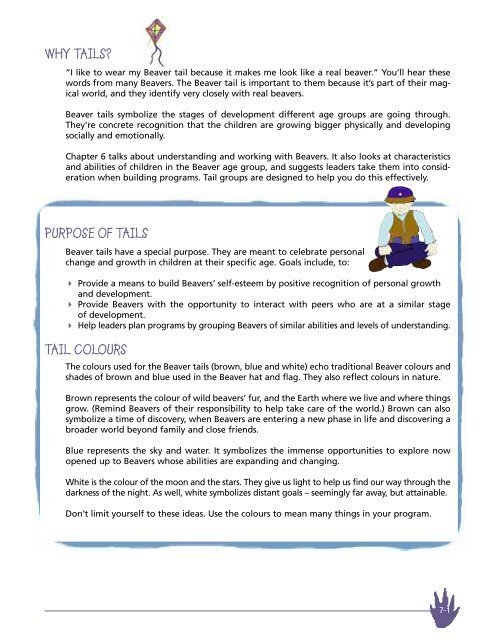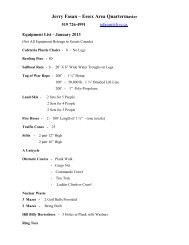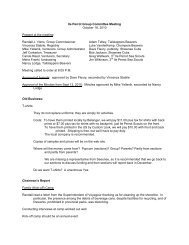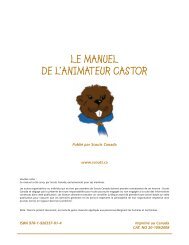Beaver Leader's Handbook - Scouts Canada
Beaver Leader's Handbook - Scouts Canada
Beaver Leader's Handbook - Scouts Canada
You also want an ePaper? Increase the reach of your titles
YUMPU automatically turns print PDFs into web optimized ePapers that Google loves.
WHY TAILS?<br />
“I like to wear my <strong>Beaver</strong> tail because it makes me look like a real beaver.” You’ll hear these<br />
words from many <strong>Beaver</strong>s. The <strong>Beaver</strong> tail is important to them because it’s part of their magical<br />
world, and they identify very closely with real beavers.<br />
<strong>Beaver</strong> tails symbolize the stages of development different age groups are going through.<br />
They’re concrete recognition that the children are growing bigger physically and developing<br />
socially and emotionally.<br />
Chapter 6 talks about understanding and working with <strong>Beaver</strong>s. It also looks at characteristics<br />
and abilities of children in the <strong>Beaver</strong> age group, and suggests leaders take them into consideration<br />
when building programs. Tail groups are designed to help you do this effectively.<br />
PURPOSE OF TAILS<br />
<strong>Beaver</strong> tails have a special purpose. They are meant to celebrate personal<br />
change and growth in children at their specific age. Goals include, to:<br />
4 Provide a means to build <strong>Beaver</strong>s’ self-esteem by positive recognition of personal growth<br />
and development.<br />
4 Provide <strong>Beaver</strong>s with the opportunity to interact with peers who are at a similar stage<br />
of development.<br />
4 Help leaders plan programs by grouping <strong>Beaver</strong>s of similar abilities and levels of understanding.<br />
TAIL COLOURS<br />
The colours used for the <strong>Beaver</strong> tails (brown, blue and white) echo traditional <strong>Beaver</strong> colours and<br />
shades of brown and blue used in the <strong>Beaver</strong> hat and flag. They also reflect colours in nature.<br />
Brown represents the colour of wild beavers’ fur, and the Earth where we live and where things<br />
grow. (Remind <strong>Beaver</strong>s of their responsibility to help take care of the world.) Brown can also<br />
symbolize a time of discovery, when <strong>Beaver</strong>s are entering a new phase in life and discovering a<br />
broader world beyond family and close friends.<br />
Blue represents the sky and water. It symbolizes the immense opportunities to explore now<br />
opened up to <strong>Beaver</strong>s whose abilities are expanding and changing.<br />
White is the colour of the moon and the stars. They give us light to help us find our way through the<br />
darkness of the night. As well, white symbolizes distant goals – seemingly far away, but attainable.<br />
Don’t limit yourself to these ideas. Use the colours to mean many things in your program.<br />
7-1








